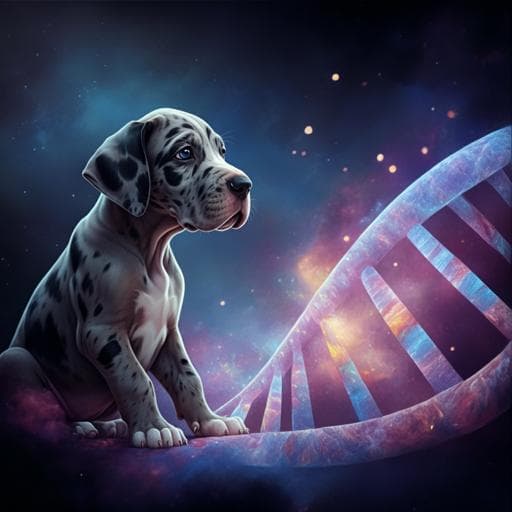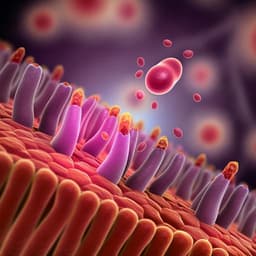
Veterinary Science
A novel genomic region on chromosome 11 associated with fearfulness in dogs
R. Sarviaho, O. Hakosalo, et al.
This groundbreaking study, conducted by R. Sarviaho and colleagues, uncovers the genetic basis of fearfulness in Great Dane dogs. Through a genome-wide association study, the researchers identified a significant locus on chromosome 11 linked to fear, with candidate genes like MAPK9/JNK2. This research not only sheds light on canine anxiety but also serves as a promising model for understanding human anxiety disorders.
~3 min • Beginner • English
Introduction
Fear is an emotional state caused by stimuli predicting or causing danger and produces behaviours aimed at survival. Excessive fearfulness and anxiety constitute psychiatric conditions in humans and behavioural problems in dogs. In humans, anxiety disorders and specific phobias have lifetime prevalences over 15% and 7.4%, respectively, and are heritable yet genetically complex, underscoring the need for physiologically relevant animal models. Domestic dogs are valuable models for disease and behaviour due to natural phenotypic variation, unique genetic architecture, physiological similarity, and shared environment with humans. Fearful behaviours are common in dogs and can impair welfare and pose risks to humans. Fear in dogs can be social (unfamiliar people or dogs) or non-social (novel situations), and prior work suggests correlations between these traits. Reliable behavioural measurement and complex genetic architecture have challenged locus discovery. Prior studies have identified loci for canine fearfulness and noise sensitivity and biochemical changes (e.g., elevated plasma glutamine) in fearful dogs, as well as candidate loci for fear, aggression, social behaviour, and obsessive-compulsive disorder. Environmental factors, particularly the extent of puppyhood socialisation, strongly influence fearfulness; thus, incorporating such covariates may strengthen genetic analyses. This study focuses on mapping the genetic background of fear of strangers in Great Danes (GD) using a validated survey-derived stranger fear score (SFS), genome-wide association, and sequencing to identify candidate loci and genes.
Literature Review
- Human context: Anxiety disorders and specific phobias have high lifetime prevalence (>15% and 7.4%), are heritable but genetically complex, necessitating animal models for molecular discovery.
- Dogs as models: Dogs offer natural behavioural variation, breed structures, and shared human environments that aid genetic mapping of behaviour.
- Prior canine findings: Reported loci for fearfulness and noise sensitivity; metabolic alterations (e.g., increased plasma glutamine) in fearful dogs; candidate loci/genes identified for fear and aggression, social behaviour, and canine OCD.
- Environmental influences: Puppyhood socialisation critically impacts fearfulness; limited early experiences increase fear; integrating environmental covariates like socialisation into genetic studies is recommended to bolster signals.
Methodology
Study design and cohorts:
- Recruitment: Finnish Great Dane dogs recruited via a validated owner-completed behavioural survey focused on fearfulness.
- Phenotyping: 124 GDs scored using the stranger fear score (SFS), a quantitative categorical measure of frequency and intensity of fear reactions to unfamiliar people. SFS = (sum of fear behaviours, with withdrawal weighted ×5) × (frequency of reactions); range 0–48. Controls had SFS=0 and owner-indicated friendly/neutral greeting behaviours; cases had SFS>0. A subset (15 cases, 13 controls) was validated by behavioural testing. Controls were >1 year old; some cases slightly <1 year if behaviourally tested.
- Socialisation score (SS): Quantitative categorical measure of puppyhood socialisation between 7 weeks and 3 months; range 0–35. Used as a covariate; unavailable for 14 dogs. For analyses, SS was binned into four ordered categories: 0–10, 10–20, 21–24, 25–35.
- Additional phenotype: Fear in novel situations score available for a subset (controls: 35/72; cases: 27/52) but not used as inclusion criterion.
Samples:
- EDTA blood from 124 privately owned GDs; DNA extracted (Chemagen robot), quantified (Qubit 3.0; NanoDrop ND-1000). Ethical approval: ESAVI/6054/04.10.03/2012.
Genome-wide association study (GWAS):
- Genotyping: Illumina CanineHD 173k SNP array.
- Cohorts: Whole cohort: 52 cases (29F/23M), 72 controls (44F/28M). Covariate cohort (with SS): 44 cases (23F/21M), 66 controls (40F/26M).
- QC: SNP call rate >90%; individual call rate >90%; MAF >1%; HWE P ≥ 1×10−8. Post-QC: 122,529 SNPs retained; no individuals removed.
- Analyses: Quantitative trait association (PLINK), linear regression (PLINK), and mixed model (GenABEL) with genomic control or polygenic effect to adjust for relatedness/stratification. Assessed stratification via MDS and QQ plots. Multiple testing: Bonferroni and effective number of tests (simpleM). Effective tests: PLINK whole 34,271; PLINK covariate 32,773; GenABEL whole 34,097; GenABEL covariate 32,678. Significance thresholds: Bonferroni 4.08×10−7; simpleM-based ~1.46–1.53×10−6 depending on cohort/method. LD/clumping via PLINK (window 4000 kb).
Sequencing:
- Whole exome sequencing (WES): 8 cases, 8 controls selected based on opposite haplotypes at GWAS best SNP (chr11:430,548 G>A; BICF2P368048), one case heterozygous; cases had SFS 16–28; 4 cases and 4 controls also behaviourally tested. Library: Roche/Nimblegen (120705_CF3_Uppsala_Broad_EZ_HX1). Coverage: ~26–104×; ~105,843 variants/sample.
- Whole genome sequencing (WGS): 4 cases, 2 controls (subset of WES) on Illumina HiSeqX; coverage ~26–33×; ~6,574,191 variants/sample.
- Variant filtering: Genotype Query Tools and in-house pipeline. Dominant model filters: for WES, cases filtered against controls allowing up to two cases as WT homozygotes per variant; controls filtered allowing two controls WT homozygotes. For WGS, four cases filtered against two controls allowing a variant to be missing in at most one case. Functional annotation via Ensembl VEP. Allele frequencies assessed using 1084 canine exomes/genomes (Dog Biomedical Variant Database Consortium). Conservation via Clustal Omega. Mobile element insertions and structural variants identified per Dillard et al.; WGS cases filtered against controls under dominant model. Reference genome: CanFam 3.1. Data deposited: NCBI SRA BioProject PRJNA630029 (16 WES, 6 WGS GD samples).
Sanger validation:
- PCR and Sanger sequencing in 40 GDs (15 cases, SFS 3–25; 25 controls) for three candidate variants: chr11:1,472,008 G>A (SNP1292825), chr11:3,390,145 GGGGAA>G (rs851847854), chr11:3,416,964 G>T (rs851521203). Standard primer design; amplification with AmpliTaq Gold 360 Mastermix or Biotools DNA Polymerase; post-PCR cleanup and sequencing on ABI 3730; analysis in Sequencher 5.1.
Statistical controls:
- Genomic inflation factors λ: 1.097 (whole), 1.072 (covariate), indicating moderate stratification
Key Findings
- Phenotypes: 124 Great Danes phenotyped for stranger fear; cases SFS 1–30 (median 16; mean 14.6); controls SFS=0. Socialisation scores (SS) 3–30 (median 21.5; mean 20.2). SS distribution similar between cases and controls, supporting a genetic component.
- GWAS locus: Significant association on canine chromosome 11. With socialisation as a covariate, PLINK linear model reached genome-wide significance (Bonferroni and simpleM thresholds). Without covariate, PLINK signal significant only by simpleM; GenABEL mixed model signals did not reach genome-wide significance.
- Lead signals/regions: Best SNP around chr11:430,548 (BICF2P368048) and a second region with best SNPs at ~12,792,149 and 12,810,167 bp showed allelic distribution differences between cases and controls. Genotype plots revealed opposite homozygosity patterns between cases and controls in these regions.
- Candidate genes: The associated chr11 region harbours neuronal candidate genes including MAPK9/JNK2, a known hippocampal regulator of anxiety.
- Sequencing support: WES and WGS identified extensive regions of opposite homozygosity in the chr11 locus between cases and controls; multiple candidate variants prioritized and three followed up by Sanger sequencing (chr11:1,472,008 G>A; chr11:3,390,145 GGGGAA>G; chr11:3,416,964 G>T). Data supported the GWAS locus.
- Quality metrics: Genomic inflation λ values 1.097 (whole) and 1.072 (covariate) indicated moderate stratification managed by genomic control/polygenic terms. Post-QC SNPs: 122,529; effective number of independent tests ~32.7k–34.3k; significance thresholds: Bonferroni 4.08×10−7; simpleM ~1.46–1.53×10−6.
Discussion
The study addressed whether fear of strangers in Great Danes has a genetic component and identified a robust locus on chromosome 11. The inclusion of puppyhood socialisation as a covariate strengthened the association signal, consistent with the known environmental impact of early-life experiences on fearfulness and supporting a gene–environment-informed mapping strategy. Opposite homozygosity patterns between cases and controls in the associated region, corroborated by WES/WGS, indicate a haplotype-level difference linked to the phenotype. The presence of neuronal candidate genes such as MAPK9/JNK2 in the locus aligns with biological plausibility given MAPK9/JNK2’s role in hippocampal regulation of anxiety. Mixed-model analyses were more conservative and did not reach genome-wide significance, reflecting potential power loss due to overcorrection in structured canine populations. Overall, the findings provide genetic evidence for a locus influencing fear of strangers in dogs and suggest shared biology with human anxiety-related pathways, highlighting dogs as a valuable model for dissecting the molecular underpinnings of anxiety-related behaviours.
Conclusion
This study identifies a novel genomic region on canine chromosome 11 associated with fear of strangers in Great Danes. Incorporating an environmental covariate (puppyhood socialisation) improved detection of the signal. Sequencing data revealed opposite homozygosity patterns and prioritized neuronal candidate genes within the locus, including MAPK9/JNK2. These results advance the molecular understanding of fearfulness in dogs and support their utility as natural models for human anxieties. Future work should fine-map the chr11 locus, functionally characterise candidate variants/genes, evaluate gene–environment interactions, and assess replication across breeds and related fear phenotypes.
Limitations
- Moderate population stratification (λ≈1.10 and 1.07) despite adjustments may influence association results.
- Socialisation score was unavailable for 14 of 124 dogs, reducing the covariate cohort to 110 and potentially limiting power.
- Mixed-model (GenABEL) analyses did not reach genome-wide significance, indicating possible power loss due to overcorrection.
- Phenotyping relied primarily on owner-completed questionnaires (albeit validated), with behavioural test validation only in a subset.
- The study focused on a single breed (Great Dane), which may limit generalizability across breeds without replication.
- Fear in novel situations scores were missing for many dogs and not used for inclusion, potentially leaving unaccounted behavioural heterogeneity.
Related Publications
Explore these studies to deepen your understanding of the subject.







